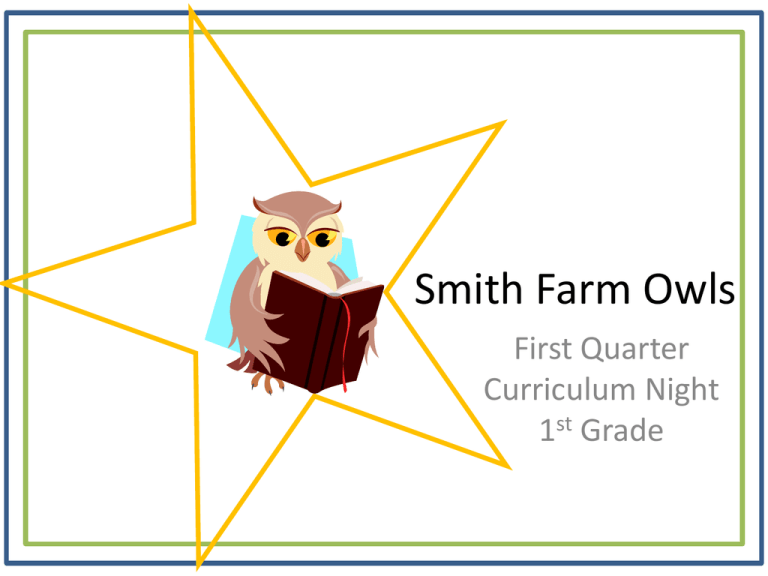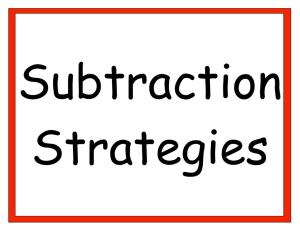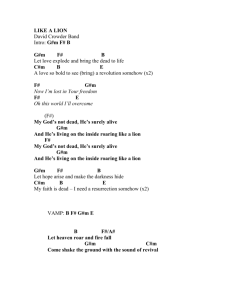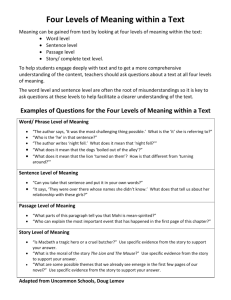First Quarter Curriculum Night Presentation
advertisement

Smith Farm Owls First Quarter Curriculum Night 1st Grade I can… apply grade level phonics and word analysis skills in decoding words. identify the main idea and retell a story including characters, details, and sequence. tell the difference between fiction and nonfiction stories. ask and answer questions related to a reading passage. write sentences including a capital letter at the beginning and punctuation at the end. write a piece that includes four sentences about one topic. a about after all am an and any are around as ask at away be before big blue boy brown but by call came can come could day did do don’t down every five for four from get girl go going good got green had has have he help her here him his how I if in into is it its jump just know like little long look make me my no now of old on one or out over pretty take that the their them then there they this to too two up very walk want was water way well went we were what when where will with would yellow yes you your Ways to Practice High Frequency Words at Home • • • • • • • • • • • • Use pennies/cereal to spell out HF words Write HF words using side walk chalk Write HF words on fogged mirrors after bath time Write HF words in different colors with markers Drill and practice with HF words (flash cards) Find HF words anywhere around the house or neighborhood Find HF words in books you read together Play board games spelling HF words (Scrabble Jr., Boggle) Cut out letters from magazines/newspaper to build HF words Make HF words out of play dough/string/yarn, etc See how many sight words you can hear/find while watching TV; write them down Type HF words on a computer or phone I Can… Math explain how to count to 30 from any given number. demonstrate what number comes next. represent two-digit numbers with manipulatives or drawings that consist of tens (such as ten-strips) and ones. For example, these base-10 tiles represent 34. verbalize the number of tens and ones that represent twodigit numbers (e.g., for 34, the student says, “Thirty-four is composed of three tens and four ones.”). represent by modeling, drawing, and showing a number sentence to show how to solve a result unknown problem. demonstrate how to join or separate objects in drawings. solve a result unknown word problem by modeling, drawing, and showing a number sentence with addition and subtraction. solve addition and subtraction word problems by using counting-on as a strategy for adding on a smaller number to a larger number, and use counting back as a strategy for subtracting a smaller number from a larger number. directly compare object A to object C, and directly compare object B to object C, and make a statement comparing the length of object A and B. organize three objects in order from longest to shortest. Important Vocabulary Math continue, count, counting, next, number, numbers (0-30), sequence, tens, ones, bundle, left-overs, singles, groups, greater/less than, equal to add, addition and subtraction sentences, altogether, breaking apart, combined, equal, in all, minus, plus, putting together, same as, true and false, unknown subtraction, counting on, counting all, counting back measure, order, length, height, more, less, longer than, shorter than, first, second, third, gap, overlap, about, a little less than, a little more than Ways to Practice Basic Math Skills at Home • Count the steps in your house/apartment building/places you go • Find different shapes in your house and tell about them • Count the number of red/blue/black/white vehicles you see while traveling near or far • Count as high as you can to a younger sibling or cousin • Practice writing numbers 1 – 50 • Practice reading numbers on clocks/calendars/road signs • Read the dollars and cents on the price tags at a store • Sing songs about days of the week and months of the year • Each day, tell what day of the week it is and the date (tell the day and the date that comes before and after, too) • Begin at different numbers and count on to 50 while you brush your teeth • Draw number lines with sidewalk chalk and read the numbers • Use your feet to measure the distance from one point to another in your house or yard and count out loud • Type numbers 1 – 50 on a computer or phone I CAN… explain what plants need including air, water, light, space, food, and shelter. explain what animals need including air, water, space, food, and shelter. tell how plants and animals get what they need from their environment. give examples of how plants and animals meet their needs in NC and in other places. describe different ways that humans protect their environment. Important Vocabulary Seeds Stem Leaves Roots Life Cycle Seedling Fruit Flower Plants Energy Grow/Growth Water Nutrients Light Animals Basic Needs Air Shelter Air Water Space Food Shelter Environment Plants Dispose of Water Nonliving Things Living Things Organisms Natural Environment Constructed Environment Protection Animals Recycled Reuse Litter Natural Temperature I Can… Explain what rules are and why they are necessary. Give examples of rules that are appropriate for home, school, and community. Discuss the character traits of good citizenship. Explain who authority figures are, and what they do. Classify the roles of authority figures in the home, school, and community. Discuss ways in which conflicts may be resolved in the home, school, classroom, and community. Define culture. Compare the languages, traditions, and holidays of various cultures. Compare and contrast how people from other cultures live, work, and play. Discuss ways various cultures take care of human needs and concerns. Discuss how literature, art, and music can help us learn about diverse cultures. Important Vocabulary • • • • • • • • • Rules Citizenship Character Appropriate Authority Figure Conflict Resolve Well-being Classify • • • • Culture Traditions Customs Beliefs Winning Attitude Independent Thinker Self Respect Excellence Everywhere In Perkins' Pride we have a Classroom Economy and every Friday is Pay Day! Students earn Lion Bucks for a job well done in the classroom. Students earn $5.00 each day they attend school. Students are also paid $5.00 each week for completing their homework. That's $30 a week for coming to work and doing their job! Students can earn extra spending money by following our class expectations. Lion Bucks are paid for super classwork, excellent behavior, sharing, and participation inside the classroom. But wait... Students are also expected to pay their bills once a month before going shopping in the Lion Store. Students must pay rent for the space they use at school. They must also pay an electric bill, a water bill, and a pet care fee each month. After the bills are paid students enjoy shopping in the Lion Store. Students will learn to keep a journal of their earnings and expenses. They will learn to count by ones, fives, and tens; make change; record, add, and subtract money (almost like adults do in a check register); and understand the concepts of wants versus needs and choosing whether to save or spend. It is exciting to watch students decide whether to spend all of their Lion Bucks on small items in the Lion Store or save some of their Lion Bucks to buy a bigger item later. Many interesting items are available for purchase with Lion Bucks. Ask your student about pay day and what he or she is saving up to buy! AFRICA Languages ANIMALS Habitats different Friends school GLOBE CULTURE alike HOME maps CELEBRATIONS WEATHER AFRICA







